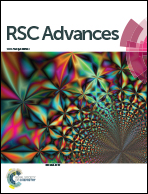Magnetic-EpCAM nanoprobe as a new platform for efficient targeting, isolating and imaging hepatocellular carcinoma†
Abstract
Herein, magnetic-EpCAM nanoparticle (EpCAM-MNP) was developed and exploited as nanoprobe for targeting, isolating and imaging hepatocellular carcinoma. The nanoprobe was composed of two major components including aminosilane-coated iron oxide nanoparticles and DNA-based EpCAM aptamers. Extensive studies were carried out to investigate its physico-chemical properties, magnetic relaxivity, as well as biocompatibility. The results indicated that the small size of the nanoprobe (HD < 100 nm) had high R2 relaxivity with good biocompatibility. Study on cellular accumulation and cellular uptake demonstrated high accumulation of EpCAM-MNP that was internalized via receptor-mediated endocytosis, as evidenced by TEM analysis. By using a magnetic-activated cell sorting (MACS) approach, the majority (∼96%) of the HepG2 cells were isolated, indicating the feasibility of our nanoprobe for isolating EpCAM-positive cells in clinical application. Because of the high intracellular accumulation and the high R2 relaxivity of EpCAM-MNP, it can be used for quantitative MRI detection of cancer cells with high sensitivity.


 Please wait while we load your content...
Please wait while we load your content...